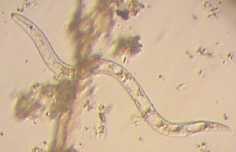Nematodes and Tree Growth
 A grower made a request for a visit to his orchard due to poor growth by his replanted first leaf trees. The trees were replacing trees that were lost to heavy winds from the previous summer. Within the orchard, there were several different pollinators, and all of the trees were planted on Lovell rootstock. This orchard was located in a sand/loamy sand soil series, irrigated with solid-set sprinklers, with trees ranging from 1rst-15th leaf throughout the block.
A grower made a request for a visit to his orchard due to poor growth by his replanted first leaf trees. The trees were replacing trees that were lost to heavy winds from the previous summer. Within the orchard, there were several different pollinators, and all of the trees were planted on Lovell rootstock. This orchard was located in a sand/loamy sand soil series, irrigated with solid-set sprinklers, with trees ranging from 1rst-15th leaf throughout the block.
Often with replanted trees in an established orchard, it is very difficult to obtain vigorous growth. The trees usually are partially shaded out, receive either too much or too little water and fertilizer, and generally struggle with soil problems involved with replanting.
The replants throughout the orchard were showing signs of low vigor, which include poor shoot growth, thinned canopy, and a general weak appearance (Pictures 1 and 2). The trees showed no other signs of disease on the scaffolds or trunk. Upon root excavation, a poorly developed root system was observed. There were no signs of fungal root infection or any other aggressive pathogens, vertebrate pests, or insects.
Picture 1: A first leaf almond tree severely stunted by high nematode populations.
Picture 2: A first leaf almond tree moderately stunted by high nematode populations.
At this point, I decided to sample for plant parasitic nematodes. Sampling for nematodes is relatively easy: Remove the top 6" of soil from the sampling locations, and use a soil sampling tube* to remove soil from the depth of 6"-18" and place the soil in a bucket. Do this from 4-5 locations and mix the soil thoroughly within the bucket. Pull out 2-3 pounds of soil, place it in a labeled plastic bag, and place in a cooler or refrigerator until the sample can be sent to a processing lab. Do this from 4-5 locations randomly throughout the orchard.
There are four nematodes of concern for almond trees. They include Rootknot Nematode (Meloidogyne sp.), Ring Nematode (Criconemella sp.), Lesion Nematode (Pratylenchus sp.), and Pin Nematode (Paratylenchus sp.). These nematodes feed on tree roots, causing damage to the root system, preventing the uptake of water and nutrients. Nematodes survive as eggs in the soil and as adults and juveniles if a food source (roots) is present. It is important to remember that tree roots can live and host nematodes for several years after a mature tree has been removed. Therefore root removal to the maximal possible depth will help reduce nematode populations.
Submitted samples and resulting nematode counts from the visited orchard were as follows:
Results are shown as # of nematodes per cubic liter of soil.
Upon seeing the nematode counts, it was clear that the stunting was due to the high populations of root lesion and ring nematodes. The high population threshold for Ring and Lesion Nematode is 100 nematodes/cubic liter of soil.
Upon seeing these numbers, I advised the grower to take some sort of pre-plant measure to reduce the nematode populations. These include the application of the pre-plant fumigant Telone (1,3-dichloropropene), cover cropping with a non-host plant (i.e. True Sudan Grass), backhoeing and leave fallow for 1-2 years, plant a resistant rootstock, or any combination of the above. The goal of these pre-plant practices is to reduce the ring and lesion nematode populations below a 50 nematodes per cubic liter of soil - the lower the population, the better.
Typically, with this high of a population, I would recommend fumigating. Due to environmental regulations and his proximity to a school, however, the application of fumigants was not possible. We decided to remove the trees, backhoe to thoroughly mix the soil and remove the old roots, and plant a cover crop for one year. We then decided to try a few different rootstock that may have tolerance to Ring and Lesion Nematodes. These include the nursery available rootstocks of Viking (Tolerance to Ring, Resistance to Rootknot), Lovell (Tolerance to Ring, Susceptible to Rootknot) and Brights #5. A more extensive list of nematode resistant rootstocks can be found from Dr. Michael McKenry's report in the 2008 Proceedings of the Almond Board of California. I will let you all know how these rootstocks perform in the future years!
In general, the term "resistant rootstock" is used when the rootstock does not allow the nematode to feed/reproduce on the roots, while the term "tolerant rootstock" is used to describe a rootstock in which nematodes can feed on the roots, but the rate of reproduction is reduced or unknown.
